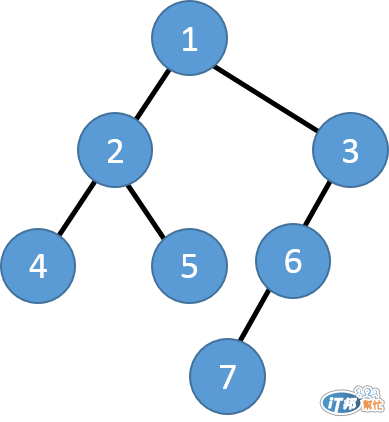**題目來源:**Maximum Depth of Binary Tree
問題:
給予一棵[二元樹][BinaryTree],試著找出他的最大深度。
// 題目對於二元樹的定義
public class TreeNode {
int val;
TreeNode left;
TreeNode right;
TreeNode(int x) { val = x; }
}
例子
所謂二元樹的深度就是從 根節點(root) 到 葉節點(leaf) 的距離。 (沒有子節點的節點稱做葉節點)

他的最大深度就是 4, 因為在所有的路徑當中從 1 到 7 號節點的距離最遠,有四個節點。
想法
關於最大深度,我們需要的是計算所有路徑的深度,然後再從這些深度中找出一個最大的即可。
所以我們需要兩個 Stack ,一個是存放 目前走訪的路徑,另一個是 暫存著我們尚未走訪的路徑。
當存放的我們 目前走訪的路徑 stack 到達 葉節點 時,我們就可以將此 stack 的 size 與目前的最大深度相比較 再將較大的那一個設定成 目前最大深度。依此類推,每走到一個葉節點,就可以比較目前的最大深度是否為最大,直到走完所有的路徑(也就是 暫存路徑的 stack 為空) 時,就可以得到最大深度了。
虛擬碼
建立一個 remainPathStack (暫存路徑)
建立一個 currentPathStack (目前走訪路徑)
Push 'root' to remainPathStack
while remainPathStack is not empty:
currentNode = remainPathStack.peek
if (currentPathStack is no empty AND currentPathStack.Peek == remainPathSTack.Peek):
if currentPathStack 的 size 大於 MaxDepth:
將 MaxDepth 設定成 currentPathSizeStack's size
pop one node from currentPathStack
pop one node from remainPathStack
else:
push 'currentNode' to currentPathStack
if node has left child:
push 'left child' to remainPathStack
if node has right child:
push 'right child' to remainPathStack
如果你用 C# 可以利用我的 測試程式 來驗證
如果你用 Java or Python or C++ 可上 LeetCode Online Judge 驗證
// 我的解法 C# 版本
public int CalculateMaxDepth(TreeNode root)
{
int maxDepth = 0;
if (root == null)
return maxDepth;
Stack<TreeNode> remainPathStack = new Stack<TreeNode>();
Stack<TreeNode> currentPathStack = new Stack<TreeNode>();
remainPathStack.Push(root);
TreeNode node;
while (remainPathStack.Count != 0)
{
node = remainPathStack.Peek();
if (currentPathStack.Count != 0 && node == currentPathStack.Peek())
{
if (currentPathStack.Count > maxDepth)
maxDepth = currentPathStack.Count;
remainPathStack.Pop();
currentPathStack.Pop();
}
else
{
currentPathStack.Push(node);
if (node.left != null)
remainPathStack.Push(node.left);
if (node.right != null)
remainPathStack.Push(node.right);
}
}
return maxDepth;
}
來做一點點小小的 refactor 吧,讓程式碼更加友善,雖然有點過頭,但也挺有趣的,不是嗎?讓程式碼像文章一樣!
// 有點重構過頭的 C# 版本
public int CalculateMaxDepth(TreeNode root)
{
int maxDepth = 0;
if (root == null)
return maxDepth;
Stack<TreeNode> remainPathStack = new Stack<TreeNode>();
Stack<TreeNode> currentPathStack = new Stack<TreeNode>();
remainPathStack.Push(root);
TreeNode node;
while (IsNotEmpty(remainPathStack))
{
node = remainPathStack.Peek();
if (IsCurrentPathDownToLeafOrOnBackWay(currentPathStack, node))
{
if (currentPathStack.Count > maxDepth)
maxDepth = currentPathStack.Count;
remainPathStack.Pop();
currentPathStack.Pop();
}
else
{
currentPathStack.Push(node);
if (node.left != null)
remainPathStack.Push(node.left);
if (node.right != null)
remainPathStack.Push(node.right);
}
}
return maxDepth;
}
private static bool IsNotEmpty(Stack<TreeNode> currentPathStack)
{
return currentPathStack.Count != 0;
}
private static bool IsCurrentPathDownToLeafOrOnBackWay(Stack<TreeNode> currentPathStack, TreeNode node)
{
// 因為當目前的節點沒有任何子節點時, remainPathStack 就不會 push 節點進去
// 此時,remainPathStack 的 peek 會和 currentPathStack 的 peek 相同
if (currentPathStack.Count == 0)
return false;
return node == currentPathStack.Peek();
}
